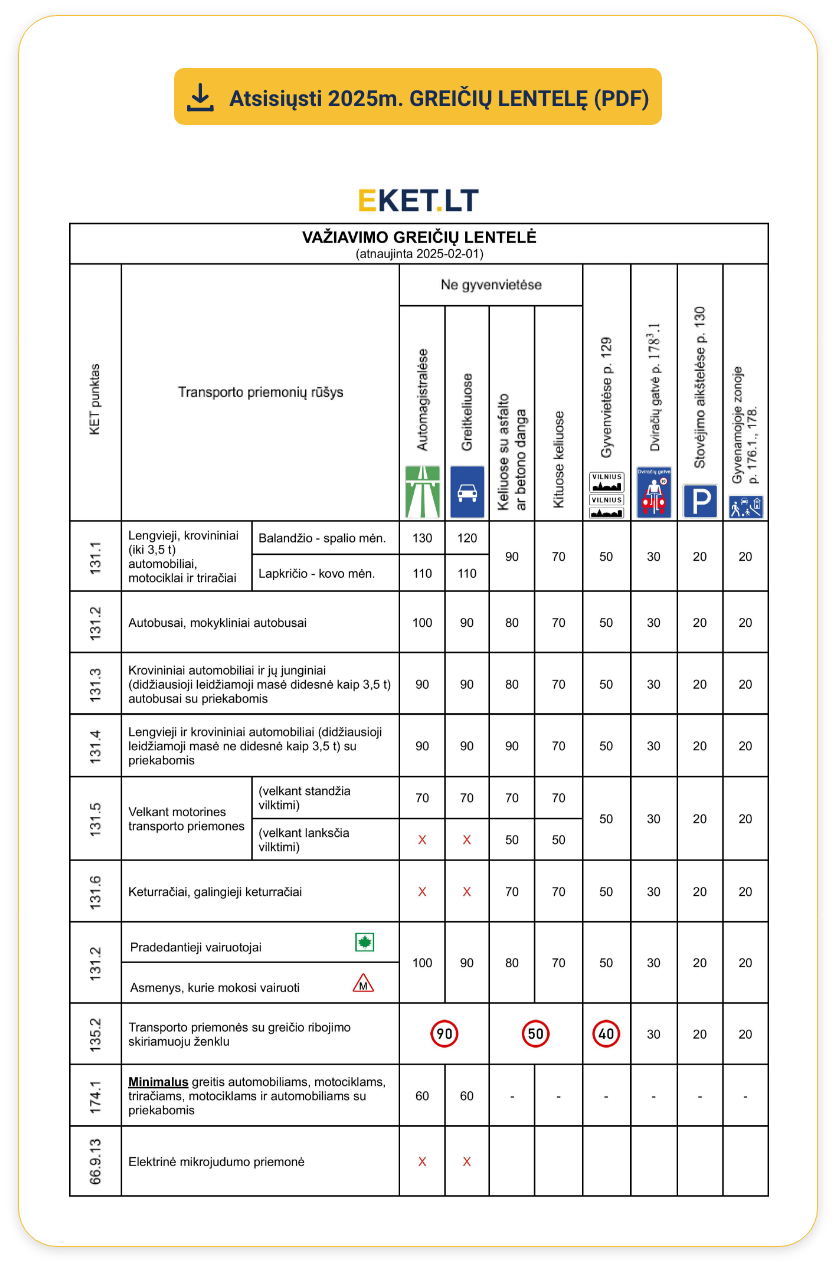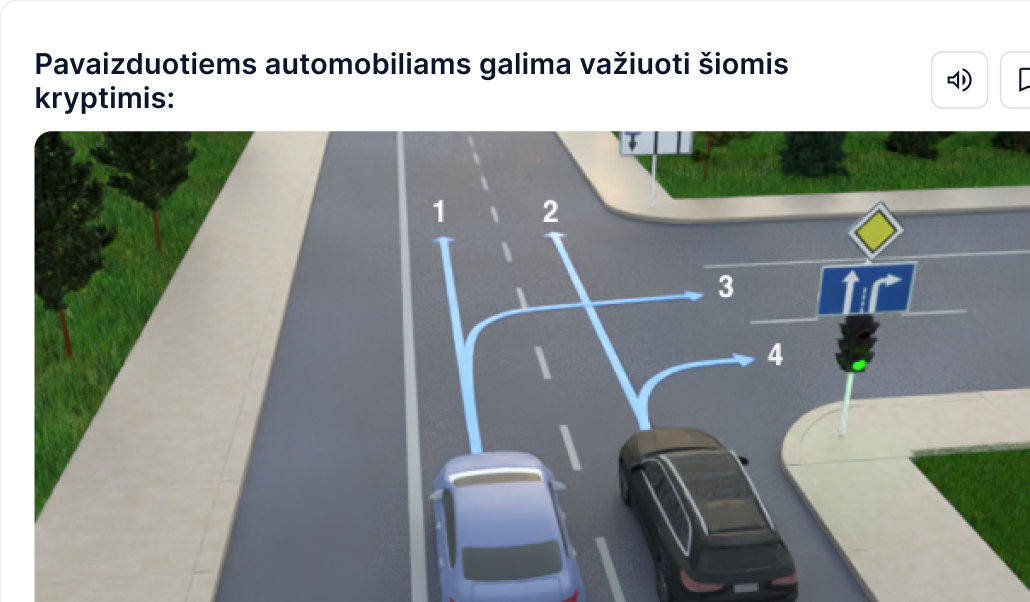KET Speed Table 2025 PDF (permitted driving speeds)
To download the latest driving speed chart CLICK HERE .
Ekis Paprastai
2025 September 18
5 min. read

Driving speed (KET p. 127-135)
127. The driver must drive within the permitted speed limit. When choosing the speed, the driver must take into account the driving conditions, in particular the terrain, the condition of the road and the vehicle and its load, the meteorological conditions, as well as the traffic intensity, in order to be able to stop the vehicle before any foreseeable obstacle. He must slow down and stop if necessary, if the circumstances so require, especially when visibility is poor.
128. If an obstacle or a threat to traffic safety has arisen, the driver (if he can notice it) must slow down, even stop the vehicle completely, or go around the obstacle without endangering other road users.
129. In residential areas, all vehicles are allowed to drive at a speed not exceeding 50 km/h .
130. In parking lots, all vehicles are allowed to drive at a speed of no more than 20 km/h .
131. Outside settlements, it is allowed to drive:
131.1. passenger cars, trucks with a maximum permissible mass not exceeding 3.5 t , motorcycles and tricycles on motorways in April-October - at a speed not exceeding 130 km/h , in November-March - at a speed not exceeding 110 km/h , on expressways in April-October - at a speed not exceeding 120 km/h , in November-March - at a speed not exceeding 110 km/h , on roads with asphalt or concrete surface - at a speed not exceeding 90 km/h , on other roads - at a speed not exceeding 70 km/h ;
131.2. Vehicles of categories A1, A2, A or B , driven by novice drivers, persons learning to drive or taking a practical driving test , buses (including school buses) on motorways - at a speed of no more than 100 km/h , on expressways - at a speed of no more than 90 km/h , on roads with asphalt or concrete surface - at a speed of no more than 80 km/h , on other roads - at a speed of no more than 70 km/h ;
131.3. trucks with a maximum permissible mass exceeding 3.5 t , as well as combinations of these trucks and trailers, buses with trailers on motorways and expressways - at a speed of no more than 90 km/h, on roads with asphalt or concrete surface - at a speed of no more than 80 km/h , on other roads - at a speed of no more than 70 km/h ;
131.4. passenger cars and trucks with a maximum permissible mass not exceeding 3.5 t , with trailers on motorways, expressways and roads with asphalt or concrete surface – at a speed not exceeding 90 km/h , on other roads – at a speed not exceeding 70 km/h ;
131.5. when towing motor vehicles with a rigid towbar – at a speed not exceeding 70 km/h , and when towing with a flexible towbar – at a speed not exceeding 50 km/h ;
131.6. quadricycles, powerful quadricycles – at a speed not exceedingat a speed of 70 km/h ;
131.7. tractors and self-propelled machines – at a speed not exceeding 50 km/h .
132. If the permitted speed on roads is increased or decreased by relevant road signs, the driver must follow the requirements of the road signs, however, the driving speed chosen by the driver in built-up areas and outside built-up areas may not exceed the maximum permitted speed set in paragraph 131 of the Rules for the relevant vehicle or its combination with a trailer.
133. On sections of road where traffic conditions allow for safe driving at higher speeds, the permitted speed may be increased by the decision of the road owner by installing appropriate road signs.
135. A driver is prohibited from:
135.1. exceed the maximum speed set by the vehicle manufacturer, regardless of the fact that a higher permitted speed may be set by a road sign;
135.2. exceed the speed specified on the vehicle's speed limit sign;
135.3. drive unnecessarily too slowly, obstructing the normal traffic of other vehicles;
135.4. brake suddenly unless it is necessary for traffic safety.
Traffic in a residential area (KET p. 175-178)
175. Pedestrians are allowed to move on the carriageway throughout the residential area, but they must not obstruct the traffic of vehicles. In the residential area, pedestrians have the right of way over vehicles.
176. In a residential area it is prohibited to:
176.1. drive at a speed exceeding 20 km/h ;
176.2. to stand with the vehicle engine running for longer than is necessary to prepare the vehicle for driving (to clear snow, etc.);
176.3. to leave parked freight vehicles with a maximum permissible mass exceeding 3.5 t, buses with more than 12 seats, as well as tractors, self-propelled vehicles and their trailers;
176.4. to bend.
177. The driver of a vehicle, when entering a road from a residential area, must give way to vehicles approaching it, as well as to pedestrians whose direction of movement he is crossing.
177.1. In a residential area, the requirements set out in paragraphs 57 and 66.3 of the Rules to drive in a single file and as close as possible to the right edge of the lane do not apply to the driver of a bicycle or electric micromobility device.
178. The requirements of this section also apply to the courtyards of multi-apartment residential buildings. The provisions of clause 175 and subclause 176.4 of the Rules apply to parking lots.
Traffic on a bicycle street (KET p. 178)
178.1p. Bicycle street is intended for (mixed) traffic of non-motorized and motorized vehicles.
178.2. On a bicycle street, the requirements set out in paragraphs 57 and 66.3 of the Rules to ride in a single file and as close as possible to the right edge of the lane do not apply to the driver of a bicycle or electric micromobility device.
178.3 . It is prohibited to:
178.3p.1. drive at a speed exceeding 30 km/h ;
178.3p.2. to bend.
To better prepare for the theory test and become familiar with all the speed rules, it is useful to practice with KET tests. Free KET tests will help you consolidate your knowledge of speed limits and other traffic rules, making it easier to pass the exam at Regitra. This will give you confidence and ensure that you are prepared to comply with all requirements on the road.
Try KET tests!
Prepare for the Regitra theory exam with EKET Tickets

9/10 EKET students pass on the first try!

Frequently asked questions
Here you will find answers to common questions. If you did not find your question, click Contact us and we will gladly help.

Did not find an answer?
Contact us and we will help!
Information updated 2025-09-18
Related articles

2025 September 19
7 min. read
Categories A, A1, A2, AM
Ekis Paprastai

2025 September 19
3 min. read
Car dashboard symbols and their meanings
Ekis Paprastai

2025 September 19
3 min. read
What do the regulator signals mean?
Ekis Paprastai

2025 September 19
2 min. read
Braking distance/stopping distance
Ekis Paprastai
Other articles
Regitra Exam Fees – Theory and Practical License Costs
When do you need to retake your driving license? [2025 Information]
(NON) Critical Errors at Regitra: Possible Error Types 2025
Traffic fines: speeding, driving without inspection and other violations 2025
Driving categories 2025: Descriptions, requirements, notes
B, B1, BE Categories
Best KET tests (tickets) 2025
Driving exam 2025: school test, at Regitra, mistakes
Tractor driving license: categories, requirements, costs
C kategorija
Driving with the M Plate: Requirements, Opportunities, Pros and Cons, FAQ
Lost driver's license: recovery, retaking exams, required documents
Regitra questions – 20 questions before the practical exam 2025
Regitra theory exam 2025: procedure, cost, requirements
Driving Lessons: Requirements, Where to Learn, Price, FAQ
Category D
Vehicle Categories and Their Classification (Descriptions)
Beginner Driver: License, Tips, Traffic Violations
AM CATEGORY TESTS (AM, A, A1, A2 Category Driving Theory Tests)
Railway crossing
EKET.LT - More than just KET tests
EKET.LT is an innovative learning system helping you prepare for the Regitra theory exam. You will find not only KET tickets and tests here, but also constantly updated content, learning statistics, recommendations and the option to consult with an experienced instructor. Learn more effectively, track your progress and get ready to pass on the first try.
Copying or reusing any material published on “EKET.LT” is prohibited. 2021 - 2025.

